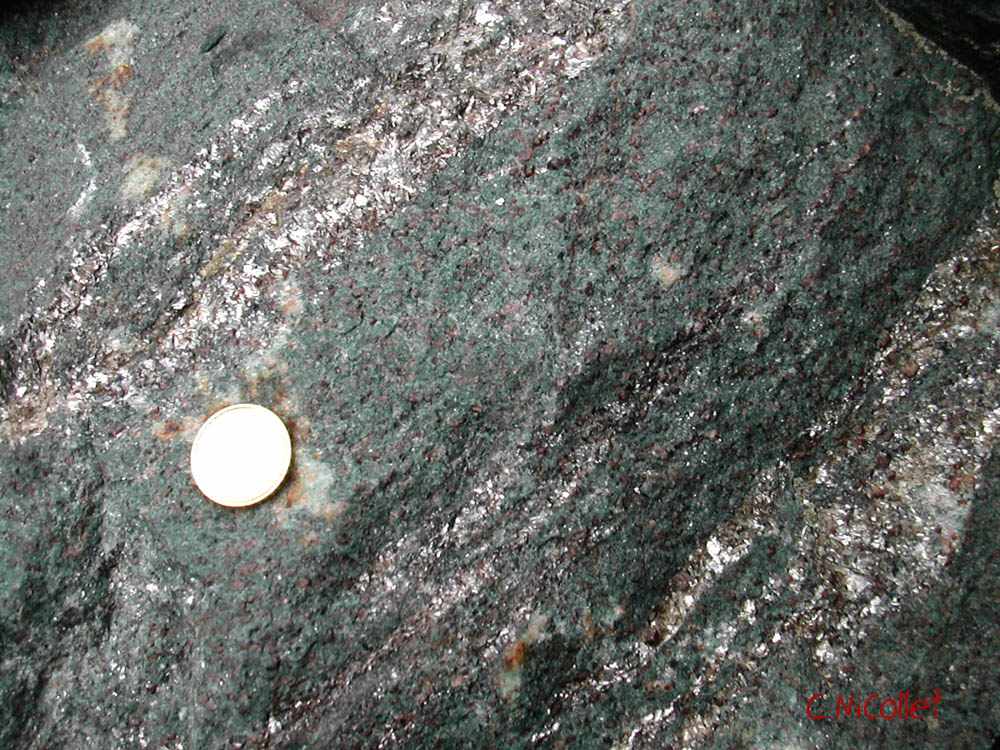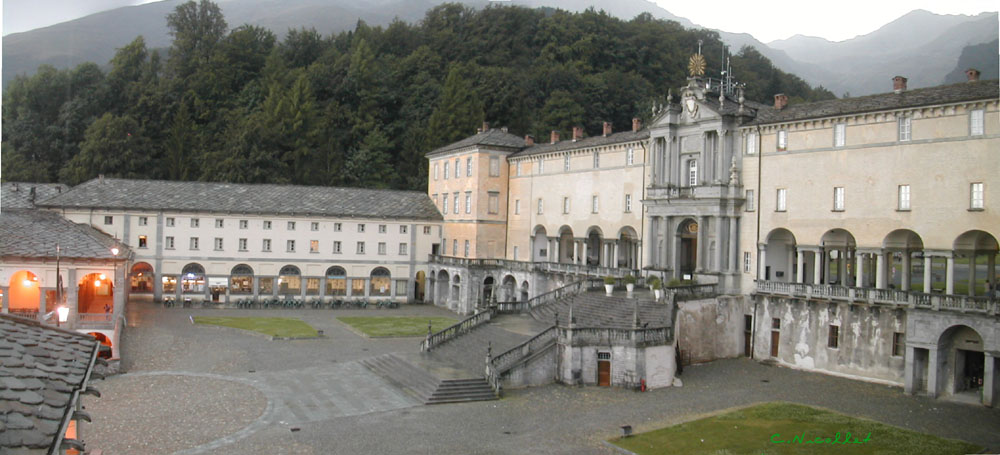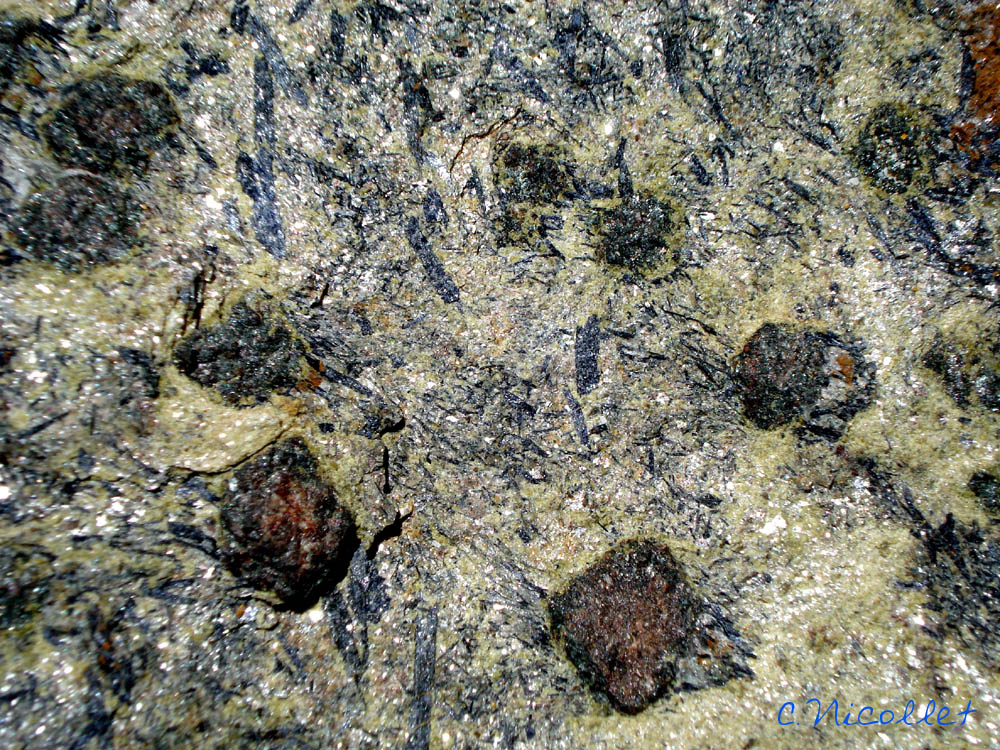Picking red fruits ... Eclogitic
Summer is the best time to pick fruit! I have a preference for red fruits: cherries, raspberries, blueberries... and of course garnets!

The mineralogical composition of this skarn is simple: red centimetric garnet and white zoisite
Summer is the time to gather fresh eclogites to replenish the mineralogical collections. But non-retromorphosed eclogites are not in abundant supply! In the Alps, these rocks can be found at the foot of the Viso or near the Matterhorn ...
An eclogite ( which was defined by Haüy in 1822) is a basic magmatic rock (basaltic or gabbroic) metamorphosed under eclogite (or eclogitic) facies. Eclogite is at least a bi-mineral rock and must contain garnet and omphacite to which may be added various accessory minerals which are: quartz or coesite, rutile, ilmenite, pyrite, kyanite, lawsonite or epidotes, orthopyroxene, amphibole, (glaucophane, hornblende), white micas (phengite, paragonite), corindon ...
Omphacite is a clinopyroxene of sodium composition, diagnostic of eclogite facies. It is a solid solution of the type diopside - hedenbergite (= magmatic Cpx) - Jadeite (= the sodic end member). Jadeite is produced from the sodic endmember of the plagioclase of the gabbro or basalt through the reaction: Albite = Jadeite + Quartz. This transformation reflects an increase in pressure (or decrease in temperature) as can be seen in the PT diagram. (See also the retrograde evolution of this réaction)
Accessory minerals, often in small quantities in the rock, are sometimes good indicators of pressure and especially temperature conditions. Some of them cannot coexist in the rock, such as, for example, coesite and quartz, lawsonite and epidote, glaucophane and green hornblende (see a LT eclogite): any of these minerals allow subdivisions to be made within the broad field of. For example, glaucophane and green hornblende characterise the LT and HT domains respectively in this facies; the boundary is at about 550°C.The same is true for lawsonite and epidote. Orthopyroxene reveals even higher T values, typical of eclogites from the mantle. Coesite indicates very high P.
But let us go back to our sample collection. A very convenient place to find eclogites is Monte Mucrone above the town of Biella near the Val d'Aosta (Italy). In fact, a superb outcrop of this rock is located at the exit of the upper station of the cable car that leads from the sanctuary of Oropa (12km from Biella) to the slopes of Monte Mucrone:

Plurimillimetric green omphacite and red garnet rods (see dry sample ?) see dry sample ?)
Here is another picture of this beautiful rock:

This rock at the exit of the cable car is ideal for macroscopic studies thanks to the multi-millimetre to centimetre size of the crystals; it consists of garnet and omphacite, glaucophane (very dark marine blue) and phengite (white mica) in variable quantities.
To make thin sections, it is best to choose an outcrop about 100 metres away, to the right of the path leading to Lake Mucrone:

Green omphacite and red garnet are millimetre-sized; the rock is locally enriched in phengite (bright white on the picture).
The crystals are of a size more suitable for making a thin section.The mineralogy of the rock is the same as the previous one: omphacite, garnet, glaucophane and phengite.
Other picture of this eclogite:

Les plages sombres dans l'omphacite verte pâles sont des cristaux de glaucophane. Remarquez un niveau de quartz en bas à droite de la photo.
And don't leave without visiting the outcrop of the eclogitised (meta)granite on the slopes of Monte Mucrone (3/4 hour from the cable car station)! Or take the Monte Camino chairlifts and walk back down to the top station of the cable car; you will pass through beautiful outcrops of eclogitic micaschists .
And the cherry on the cake (red fruits again!): it is possible to be accommodated in the huge sanctuary of Oropa ...

Let us continue the sampling of eclogites ...
... the one in Sifah (Sultanate of Oman) is a pure multicoloured wonder:

In a fine mixture of millimetre crystals, one can recognise red garnet, green omphacite, marine blue glaucophane; green-yellow epidote, white quartz.
Another sample shows centimetric crystals of glaucophane and garnet ...

... The latter is surrounded by a dark corona of glaucophane, testifying to the retromorphism of this rock under the conditions of the BlueSchists facies. Yellow epidote is abundant.
 Back to the PhotoGallery
or to the HomePage ?
Back to the PhotoGallery
or to the HomePage ?







